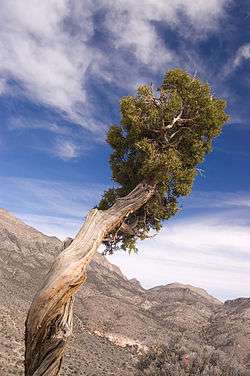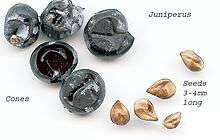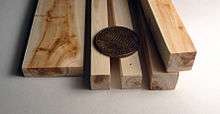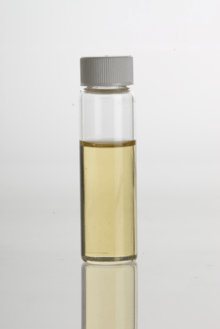Juniper
| Juniperus | |
|---|---|
 | |
| Juniperus osteosperma in Nevada, United States | |
| Scientific classification | |
| Kingdom: | Plantae |
| Division: | Pinophyta |
| Class: | Pinopsida |
| Order: | Pinales |
| Family: | Cupressaceae |
| Genus: | Juniperus L. |
| Species | |
|
See text | |
Junipers are coniferous plants in the genus Juniperus /dʒuːˈnɪpərəs/[1] of the cypress family Cupressaceae. Depending on taxonomic viewpoint, between 50 and 67 species of juniper are widely distributed throughout the Northern Hemisphere, from the Arctic, south to tropical Africa, from Ziarat, Pakistan east to eastern Tibet in the Old World, and in the mountains of Central America. The highest-known Juniper forest occurs at an altitude of 16,000 feet (4,900 m) in south-eastern Tibet and the northern Himalayas, creating one of the highest tree-lines on earth.[2]
Description

Junipers vary in size and shape from tall trees, 20–40 m (66–131 ft) tall, to columnar or low spreading shrubs with long trailing branches. They are evergreen with needle-like and/or scale-like leaves. They can be either monoecious or dioecious. The female seed cones are very distinctive, with fleshy, fruit-like coalescing scales which fuse together to form a "berry"-like structure, 4–27 mm (0.16–1.06 in) long, with 1–12 unwinged, hard-shelled seeds. In some species these "berries" are red-brown or orange but in most they are blue; they are often aromatic and can be used as a spice. The seed maturation time varies between species from 6–18 months after pollination. The male cones are similar to those of other Cupressaceae, with 6–20 scales.
In zones 7 through 10, junipers can bloom and release pollen several times each year. A few species of juniper bloom in autumn, while most species pollinate from early winter until late spring.[3]

Many junipers (e.g. J. chinensis, J. virginiana) have two types of leaves: seedlings and some twigs of older trees have needle-like leaves 5–25 mm (0.20–0.98 in) long; and the leaves on mature plants are (mostly) tiny (2–4 mm (0.079–0.157 in)), overlapping and scale-like. When juvenile foliage occurs on mature plants, it is most often found on shaded shoots, with adult foliage in full sunlight. Leaves on fast-growing 'whip' shoots are often intermediate between juvenile and adult.
In some species (e. g. J. communis, J. squamata), all the foliage is of the juvenile needle-like type, with no scale leaves. In some of these (e.g. J. communis), the needles are jointed at the base, in others (e.g. J. squamata), the needles merge smoothly with the stem, not jointed.
The needle-leaves of junipers are hard and sharp, making the juvenile foliage very prickly to handle. This can be a valuable identification feature in seedlings, as the otherwise very similar juvenile foliage of cypresses (Cupressus, Chamaecyparis) and other related genera is soft and not prickly.
Juniper is the exclusive food plant of the larvae of some Lepidoptera species including Bucculatrix inusitata and juniper carpet, and is also eaten by the larvae of other Lepidoptera species such as Chionodes electella, Chionodes viduella, juniper pug and pine beauty; those of the tortrix moth C. duplicana feed on the bark around injuries or canker.
Classification




The number of juniper species is in dispute, with two recent studies giving very different totals, Farjon (2001) accepting 52 species, and Adams (2004) accepting 67 species. The junipers are divided into several sections, though (particularly among the scale-leaved species) which species belong to which sections is still far from clear, with research still on-going. The section Juniperus is an obvious monophyletic group though.
- Juniperus sect. Juniperus: Needle-leaf junipers. The adult leaves are needle-like, in whorls of three, and jointed at the base (see below right).
- Juniperus sect. Juniperus subsect. Juniperus: Cones with 3 separate seeds; needles with one stomatal band.
- Juniperus communis - Common Juniper
- Juniperus communis subsp. alpina - Alpine Juniper
- Juniperus conferta - Shore Juniper (syn. J. rigida var. conferta)
- Juniperus rigida - Temple Juniper or Needle Juniper
- Juniperus communis - Common Juniper
- Juniperus sect. Juniperus subsect. Oxycedrus: Cones with 3 separate seeds; needles with two stomatal bands.
- Juniperus brevifolia - Azores Juniper
- Juniperus cedrus - Canary Islands Juniper
- Juniperus deltoides - Eastern Prickly Juniper
- Juniperus formosana - Chinese Prickly Juniper
- Juniperus lutchuensis - Ryukyu Juniper
- Juniperus navicularis - Portuguese Prickly Juniper
- Juniperus oxycedrus - Western Prickly Juniper or Cade Juniper
- Juniperus macrocarpa (J. oxycedrus subsp. macrocarpa) - Large-berry Juniper
- Juniperus sect. Juniperus subsect. Caryocedrus: Cones with 3 seeds fused together; needles with two stomatal bands.
- Juniperus drupacea - Syrian Juniper
- Juniperus sect. Juniperus subsect. Juniperus: Cones with 3 separate seeds; needles with one stomatal band.
- Juniperus sect. Sabina: Scale-leaf junipers. The adult leaves are mostly scale-like, similar to those of Cupressus species, in opposite pairs or whorls of three, and the juvenile needle-like leaves are not jointed at the base (including in the few that have only needle-like leaves; see below right). Provisionally, all the other junipers are included here, though they form a paraphyletic group.
- Old World species
- Juniperus chinensis - Chinese Juniper
- Juniperus chinensis var. sargentii - Sargent's Juniper (Japanese: 深山柏槇)
- Juniperus chinensis L. var. tsukusiensis Masummune (Chinese: 清水圓柏)
- Juniperus chinensis Kaizuka (Japanese: 貝塚伊吹)
- Juniperus chinensis var. Procumbens (Japanese: 這柏槇)
- Juniperus chinensis Globosa (Japanese: 玉伊吹)
- Juniperus chinensis Aurea' (Japanese: 金伊吹)
- Juniperus convallium - Mekong Juniper
- Juniperus excelsa - Greek Juniper
- Juniperus excelsa polycarpos - Persian Juniper
- Juniperus foetidissima - Stinking Juniper
- Juniperus indica - Black Juniper
- Juniperus komarovii - Komarov's Juniper
- Juniperus phoenicea - Phoenicean Juniper
- Juniperus pingii - Ping Juniper
- Juniperus pingii var. chengii
- Juniperus pingii var. miehei
- Juniperus pingii var. wilsonii
- Juniperus procera - East African Juniper
- Juniperus procumbens - Ibuki Juniper
- Juniperus pseudosabina - Xinjiang Juniper
- Juniperus recurva - Himalayan Juniper
- Juniperus recurva var. butanica
- Juniperus recurva var. coxii - Cox's Juniper
- Juniperus sabina - Savin Juniper
- Juniperus sabina var. davurica - Daurian Juniper
- Juniperus saltuaria - Sichuan Juniper
- Juniperus semiglobosa - Russian Juniper
- Juniperus squamata - Flaky Juniper
- Juniperus thurifera - Spanish Juniper
- Juniperus tibetica - Tibetan Juniper
- Juniperus wallichiana - Himalayan Black Juniper
- Juniperus chinensis - Chinese Juniper
- New World species
- Juniperus angosturana - Mexican One-seed Juniper
- Juniperus ashei - Ashe Juniper
- Juniperus arizonica - Synonym: Juniperus coahuilensis var. arizonica or Juniperus erythrocarpa var. coahuilensis. common names: Redberry Juniper, Roseberry Juniper
- Juniperus barbadensis - West Indies Juniper
- Juniperus bermudiana - Bermuda Juniper
- Juniperus blancoi - Blanco's Juniper
- Juniperus californica - California Juniper
- Juniperus coahuilensis - Coahuila Juniper
- Juniperus comitana - Comitán Juniper
- Juniperus deppeana - Alligator Juniper
- Juniperus durangensis - Durango Juniper
- Juniperus flaccida - Mexican Weeping Juniper
- Juniperus gamboana - Gamboa Juniper
- Juniperus horizontalis - Creeping Juniper
- Juniperus jaliscana - Jalisco Juniper
- Juniperus monosperma - One-seed Juniper
- Juniperus monticola - Mountain Juniper
- Juniperus occidentalis - Western Juniper
- Juniperus occidentalis subsp. australis - Sierra Juniper
- Juniperus osteosperma - Utah Juniper
- Juniperus pinchotii - Pinchot Juniper
- Juniperus saltillensis - Saltillo Juniper
- Juniperus scopulorum - Rocky Mountain Juniper
- Juniperus standleyi - Standley's Juniper
- Juniperus virginiana - Eastern Juniper (Eastern Redcedar)
- Juniperus virginiana subsp. silicicola - Southern Juniper
- Juniperus zanonii (proposed)[4]
- Old World species
Cultivation and uses

Juniper berries are a spice used in a wide variety of culinary dishes and best known for the primary flavoring in gin (and responsible for gin's name, which is a shortening of the Dutch word for juniper, genever). Juniper berries are also used as the primary flavor in the liquor Jenever and sahti-style of beers. Juniper berry sauce is often a popular flavoring choice for quail, pheasant, veal, rabbit, venison and other meat dishes.
Many of the earliest prehistoric people lived in or near juniper forests which furnished them food, fuel, and wood for shelter or utensils. Many species, such as J. chinensis (Chinese Juniper) from eastern Asia, are extensively used in landscaping and horticulture, and as one of the most popular species for use in bonsai. It is also a symbol of longevity, strength, athleticism, and fertility.
Some junipers are susceptible to Gymnosporangium rust disease, and can be a serious problem for those people growing apple trees, the alternate host of the disease.
Some junipers are given the common name "cedar," including Juniperus virginiana, the "red cedar" that is used widely in cedar drawers. "Eastern redcedar" is the correct name for J. virginiana. The lack of space between the words "red" and "cedar" indicate that this species is not a true cedar, Cedrus.
In Morocco, the tar (gitran) of the arar tree (Juniperus phoenicea) is applied in dotted patterns on bisque drinking cups. Gitran makes the water more fragrant and is said to be good for the teeth.
Some Indigenous peoples, such as the Dineh, have traditionally used juniper to treat diabetes.[5] Animal studies have shown that treatment with juniper may retard the development of streptozotocin-induced diabetes in mice.[6] Native Americans have also used juniper berries as a female contraceptive.[7] The 17th Century herbalist physician Nicholas Culpeper recommended the ripened berries for conditions such as asthma and sciatica, as well as to speed childbirth.[8]
Juniper is one of the plants used in Scottish and Gaelic Polytheist saining rites, such as those performed at Hogmanay (New Year), where the smoke of burning juniper is used to cleanse, bless and protect the household and its inhabitants.[9][10][11]
Juniper berries are steam distilled to produce an essential oil that may vary from colorless to yellow or pale green. Some of its chemical components are alpha pinene, cadinene, camphene and terpineol. Leaves and twigs of Juniperus virginiana are steam distilled to produce oil of juniper. Middle Tennessee and adjacent northern Alabama and southern Kentucky are the centers for this activity. The U.S. Forest Service has provided plans for the apparatus required. This work is typically done during periods of cold weather to reduce the loss of essential oil to evaporation, which is greater in warmer weather, and to take advantage of a time of year when labor might be more readily available.
Juniper in weave is a traditional cladding technique used in Northern Europe, e.g. at Havrå, Norway.[12]
Allergenic potential
In drier areas, juniper pollen easily becomes airborne and can be inhaled into the lungs. This pollen can also irritate the skin and cause contact dermatitis. Cross-allergenic reactions are common between juniper pollen and the pollen of all species of cypress.[3]
Monoecious juniper plants are highly allergenic, with an OPALS allergy scale rating of 9 out of 10. Completely male juniper plants have an OPALS rating of 10, and release abundant amounts of pollen. Conversely, all-female juniper plants have an OPALS rating of 1, and are considered "allergy-fighting".[3]
Footnotes
| Wikimedia Commons has media related to Juniperus. |
- ↑ Sunset Western Garden Book, 1995:606–607
- ↑ Hampe, Hampe; Petit, Re´my J. (2010). "Cryptic forest refugia on the 'Roof of the World'". New Phytologist. 185 (1): 5–7. doi:10.1111/j.1469-8137.2009.03108.x. Retrieved 2 September 2015.
- 1 2 3 Ogren, Thomas (2015). The Allergy-Fighting Garden. Berkeley, CA: Ten Speed Press. pp. 131–133. ISBN 978-1-60774-491-7.
- ↑ Adams, Robert. "Phytologia (April 2010) 92(1)" (PDF).
- ↑ McCabe, Melvina; Gohdes, Dorothy; Morgan, Frank; Eakin, Joanne; Sanders, Margaret; Schmitt, Cheryl (2005). "Herbal Therapies and Diabetes Among Navajo Indians". Diabetes Care. 28 (6): 1534–1535. doi:10.2337/diacare.28.6.1534-a.
- ↑ Swanston-Flatt, S. K.; Day, C.; Bailey, C. J.; Flatt, P. R. (1990). "Traditional plant treatments for diabetes. Studies in normal and streptozotocin diabetic mice". Diabetologia. 33 (8): 462–464. doi:10.1007/BF00405106. PMID 2210118.
- ↑ Tilford, Gregory L. (1997). Edible and Medicinal Plants of the West. Mountain Press Publishing Company. ISBN 0-87842-359-1.
- ↑ Culpeper, Nicholas (1985). Culpeper's Complete Herbal. Godfrey Cave Associates. ISBN 1-85007-026-1.
- ↑ McNeill, F. Marian (1961). "X Hogmany Rites and Superstitions". The Silver Bough, Vol.3: A Calendar of Scottish National Festivals, Halloween to Yule. Glasgow: William MacLellan. p. 113. ISBN 0-948474-04-1.
- ↑ Loughlin, Annie "Saining" at Tairis UK. Accessed 8-6-14
- ↑ Loughlin, Annie "Saining Ritual" at Tairis UK. Accessed 8-6-14
- ↑ Berge, Bjørn (2009). The Ecology of Building Materials (2nd ed.). Taylor & Francis. ISBN 978-1-85617-537-1.
References
- Adams, R. P. (2004). Junipers of the World: The genus Juniperus. Victoria: Trafford. ISBN 1-4120-4250-X
- Farjon, A. (2001). World Checklist and Bibliography of Conifers. Kew. ISBN 1-84246-025-0
- Farjon, A. (2005). Monograph of Cupressaceae and Sciadopitys. Royal Botanic Gardens, Kew. ISBN 1-84246-068-4
- Mao, K.; Hao, G.; Liu, J.; Adams, R. P.; Milne (2010). "Diversification and biogeography of Juniperus (Cupressaceae): variable diversification rates and multiple intercontinental dispersals". New Phytologist. 188 (1): 254–272. doi:10.1111/j.1469-8137.2010.03351.x. PMID 20561210.
External links
- Junipers of the world
- Gymnosperm Database - Juniperus
- "Juniperus". The Plant List. Missouri Botanical Garden. Royal Botanic Gardens, Kew.
- Arboretum de Villardebelle Photos of cones and foliage of selected species
-
 "Juniper". Encyclopædia Britannica (11th ed.). 1911.
"Juniper". Encyclopædia Britannica (11th ed.). 1911. -
 "Juniper". Encyclopedia Americana. 1920.
"Juniper". Encyclopedia Americana. 1920.